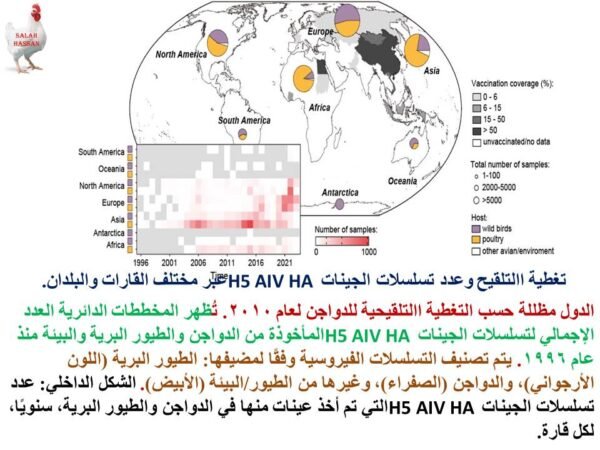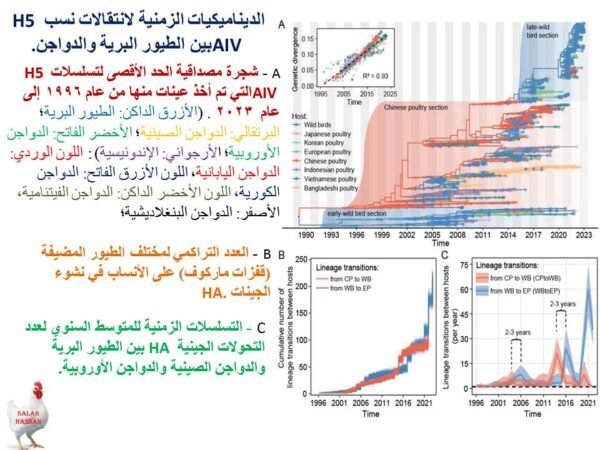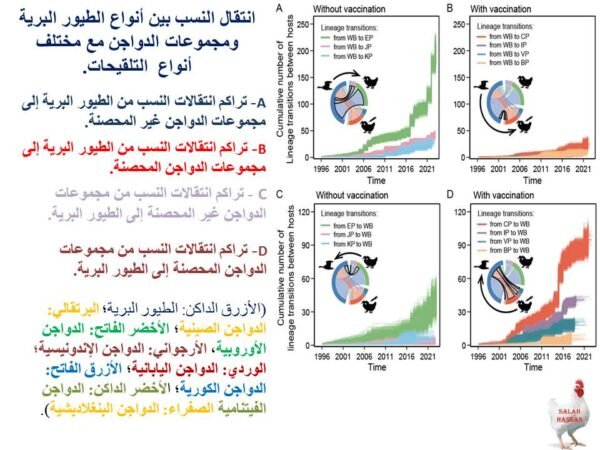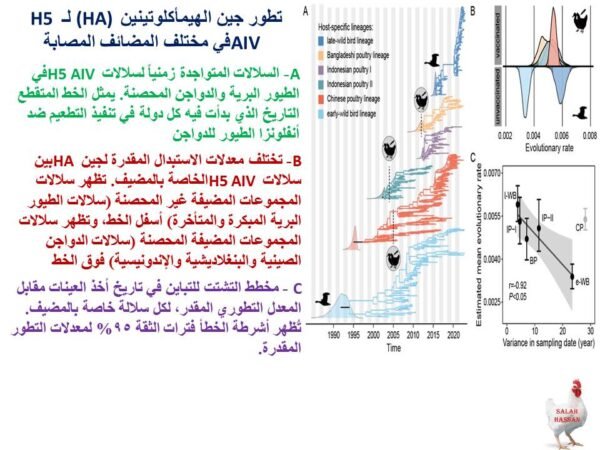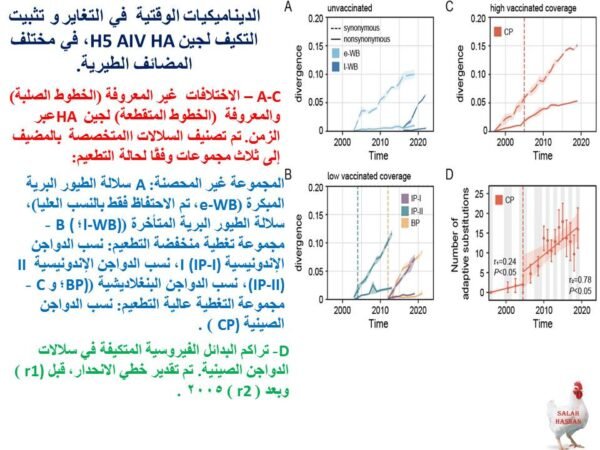The extent of the association between vaccinations against avian influenza subtype H5 with the process of spreading the virus among bird species and the events of molecular changes in the virus

Professor Dr. Salah Mahdi Hassan/ Consultant and expert in poultry diseases and production
Since 2020, avian influenza viruses subtype H5 have caused the outbreak of the disease in Europe and Asian countries as well as the United States of America, which was exposed to the effects of avian influenza subtype 2022, which also included the infection of mammals of all types, both wild and marine, which poses a real and major threat to the poultry industry and a potential threat to public health.
A recently published study dated 1/22/2025 entitled (Association of poultry vaccination with interspecies transmission and molecular evolution of H5 subtype avian influenza virus.) which was published in the journal (SCIENCE ADVANCES) in volume (11) and issue (4) and with digital coordinates (eado9140. doi: 10.1126/sciadv.ado9140. Epub 2025 Jan 22. ), The effect of mass vaccination of poultry against subtype H5 of avian influenza virus on the spread of the virus, with the possibility that these vaccines may accelerate the process of virus heterogeneity.
This study explored the dynamics of different strains of avian influenza virus circulating in vaccinated and unvaccinated poultry as well as wild birds for the period from 1996 to 2023. The study worked to reconstruct the history of the transmission of subtype H5 of avian influenza viruses in wild birds and poultry flocks treated with different vaccination programs.
The analysis of the study revealed a shift from the strain circulating in Chinese poultry to the strain circulating in wild birds. Wild bird strains have frequently been transmitted to unvaccinated European poultry, while transmission of this virus from wild birds to vaccinated poultry appears to be inhibited. Furthermore, the circulating virus lineage in highly vaccinated Chinese poultry shows evidence of unprecedented molecular and adaptive evolution in the HA gene since the introduction of mass vaccination in those poultry, which suggests that the virus strains in Chinese poultry have undergone more genetic evolution as a result of vaccination than other virus strains. She also noted that further research is needed to determine whether these genetic changes have any effect on the genetic mutations of the HA gene found in the latest wild bird virus lineage.
It is well known that due to the high prevalence of the virus in China and Southeast Asia, Chinese and Southeast Asian poultry are considered the main reservoirs of the highly pathogenic H5 HPAIV virus. The study confirmed that the spread of H5 AIV to other regions of the world was through bird migration and poultry trade, and the results of the study revealed a time delay of 2-3 years between the peak of the spread of the strain from Chinese poultry and the peak of the spread of the strain in European poultry. Although it has been previously suggested that the transcontinental spread of H5 AIV may occur during a single migration cycle of birds, the delay observed in this study may be partly attributed to pre-existing immunity in wild birds, which may provide partial protection against infection and disease, which at the same time leads to a decrease in the spread of the virus among wild birds as well as the possibility of limiting the widespread outbreak of the disease in wild birds. However, the duration of immunity conferred by previous infection with avian influenza virus and its impact on the epidemiology of the virus is still unclear. On the other hand, the relatively short lifespan of many wild birds (less than 3 years) may lead to a high turnover of seronegative wild birds in nature. With the shift of the H5 AIV reservoir from Chinese poultry to wild birds, the frequent migration and wide spatial distribution of wild birds likely facilitated interspecies transmission between wild birds and poultry flocks.
It is important for countries and regions to strengthen regular surveillance of avian influenza viruses in wild birds and effective monitoring of the virus spread dynamics.
From global observations on avian influenza and following the mass vaccination strategy of poultry adopted by China since 2005, the spread of H5 AIV has been relatively well controlled. Interspecies transmission of these viruses to or from Chinese poultry appears to be limited. However, the study suggests that the virus strain in Chinese poultry may have undergone greater antigenic evolution compared with other virus strains. Several studies have indicated that mutations at amino acid positions 136, 142, 157, 172, 201, and 205 in the H5 AIV HA gene reduce reactivity to certain types of antibodies, although amino acids at positions 142, 172, and 205 also serve as dominant immune determinants in H5 viruses. This study found genetic variation at amino acid positions 142, 157, 172, and 205 in Chinese poultry virus strains but not in wild bird virus strains or other poultry. H5N6 virus is currently circulating in Chinese poultry and shows antigenic variation from the viral strains present in the Chinese commercial vaccine, which leads to a decrease in the vaccine’s effectiveness and immunization efficiency. Therefore, this study strongly suggests that when adopting vaccination and using vaccines as one of the means of controlling avian influenza, it is necessary and obligatory to adopt regular monitoring and work on improving the vaccine used, which must contain the circulating viral variants to improve its immunization efficiency in reducing new virus infections.
While contemporary H5 HPAIV viruses are unlikely to acquire the ability to infect and spread stably among humans, there is still an urgent need to control the spread of the virus among wild birds, not only to conserve wildlife but also to ensure the safety of poultry and the environment. The study also pointed out some of the limitations that the study faced, which were in terms of scientific integrity, and were as follows:
First, although the study obtained strong results supported by different data sets, the heterogeneous sampling rates of infected wild birds and poultry may lead to bias in the readings.
Second, despite the high vaccination rate in Chinese poultry, it was not possible to extract the viral strains that are exclusively prevalent in vaccinated poultry due to the unknown vaccination status of all samples included in the study.
Third, the accurate identification of the host countries of the ancestors of the avian influenza virus strains represents a challenge for countries with limited surveillance of the influenza virus in wild bird populations.
Finally, the lack of viral genetic data and surveillance data in many vaccinating/non-vaccinating countries may prevent a comparative analysis of the evolutionary dynamics between viral strains of poultry with different vaccination levels.
In conclusion, this study showed two basic facts:
1- The results indicate that The research found that the HA (hemagglutinin) gene of the AIV subtype strain that is mostly prevalent in vaccinated Chinese poultry has undergone nonsynonymous divergence with stronger adaptive fixation than other strains.
2- The research results indicate that the epidemiological, environmental and genetic changes of widespread vaccinations against avian influenza virus in poultry may be linked to complex mechanisms and that much work and research is needed to better understand how these interactions affect the transmission of avian influenza virus to wild birds, among wild birds and from wild birds??.
As avian influenza continues to pose major challenges to the health of wild and domestic animals, such research can help in developing preventive measures against avian influenza virus, such as global vaccination policies.
Important note: I link to this article five images related to the origin of the scientific research that this article addressed.
